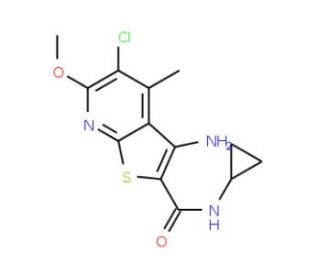

LY2033298 (CAS 886047-13-8)
QUICK LINKS
LY2033298 stands as a notable allosteric potentiator, distinguished by its high selectivity for the human M4 muscarinic acetylcholine receptor (mAChR) subtype. This compound is remarkable for its ability to enhance acetylcholine binding precisely at the M4 subtype, thereby modulating receptor activity in a highly specific manner. Its selectivity is underscored by its lack of impact on antagonist binding across the spectrum of muscarinic receptors, and it demonstrates no activity at hM1, hM3, and hM5 receptor subtypes at any explored concentration. Furthermore, its effect on the hM2 subtype is minimal, highlighting its specificity and the nuanced role it plays in receptor modulation. The precise mechanism through which LY2033298 exerts its potentiating effects offers a window into the intricate interplay between neurotransmitters and their receptors, providing valuable insights for research focused on the elucidation of receptor dynamics and the development of targeted modulators within the realm of neurochemistry.
LY2033298 (CAS 886047-13-8) References
- An allosteric potentiator of M4 mAChR modulates hippocampal synaptic transmission. | Shirey, JK., et al. 2008. Nat Chem Biol. 4: 42-50. PMID: 18059262
- New insights into the function of M4 muscarinic acetylcholine receptors gained using a novel allosteric modulator and a DREADD (designer receptor exclusively activated by a designer drug). | Nawaratne, V., et al. 2008. Mol Pharmacol. 74: 1119-31. PMID: 18628403
- Allosteric modulation of the muscarinic M4 receptor as an approach to treating schizophrenia. | Chan, WY., et al. 2008. Proc Natl Acad Sci U S A. 105: 10978-83. PMID: 18678919
- Molecular mechanisms of action and in vivo validation of an M4 muscarinic acetylcholine receptor allosteric modulator with potential antipsychotic properties. | Leach, K., et al. 2010. Neuropsychopharmacology. 35: 855-69. PMID: 19940843
- Structural determinants of allosteric agonism and modulation at the M4 muscarinic acetylcholine receptor: identification of ligand-specific and global activation mechanisms. | Nawaratne, V., et al. 2010. J Biol Chem. 285: 19012-21. PMID: 20406819
- Allosteric activators of muscarinic receptors as novel approaches for treatment of CNS disorders. | Digby, GJ., et al. 2010. Mol Biosyst. 6: 1345-54. PMID: 20582339
- Impact of species variability and 'probe-dependence' on the detection and in vivo validation of allosteric modulation at the M4 muscarinic acetylcholine receptor. | Suratman, S., et al. 2011. Br J Pharmacol. 162: 1659-70. PMID: 21198541
- Probe dependence in the allosteric modulation of a G protein-coupled receptor: implications for detection and validation of allosteric ligand effects. | Valant, C., et al. 2012. Mol Pharmacol. 81: 41-52. PMID: 21989256
- LY2033298, a positive allosteric modulator at muscarinic M₄ receptors, enhances inhibition by oxotremorine of light-induced phase shifts in hamster circadian activity rhythms. | Gannon, RL. and Millan, MJ. 2012. Psychopharmacology (Berl). 224: 231-40. PMID: 22610522
- Synthesis and pharmacological evaluation of M4 muscarinic receptor positive allosteric modulators derived from VU10004. | Huynh, T., et al. 2015. ACS Chem Neurosci. 6: 838-44. PMID: 25857219
- A kinetic view of GPCR allostery and biased agonism. | Lane, JR., et al. 2017. Nat Chem Biol. 13: 929-937. PMID: 28820879
- Discovery and Development of Muscarinic Acetylcholine M4 Activators as Promising Therapeutic Agents for CNS Diseases. | Takai, K. and Enomoto, T. 2018. Chem Pharm Bull (Tokyo). 66: 37-44. PMID: 29311510
- Cholinergic M4 receptors are involved in morphine-induced expression of behavioral sensitization by regulating dopamine function in the nucleus accumbens of rats. | Ruan, H., et al. 2019. Behav Brain Res. 360: 128-133. PMID: 30529589
- Targeting Muscarinic Acetylcholine Receptors for the Treatment of Psychiatric and Neurological Disorders. | Moran, SP., et al. 2019. Trends Pharmacol Sci. 40: 1006-1020. PMID: 31711626
- M3 but not M4 muscarinic receptors in the rostromedial tegmental nucleus are involved in the acquisition of morphine-induced conditioned place preference. | Wu, J., et al. 2020. Eur J Pharmacol. 882: 173274. PMID: 32534071
Ordering Information
| Product Name | Catalog # | UNIT | Price | Qty | FAVORITES | |
LY2033298, 5 mg | sc-300942 | 5 mg | $260.00 |
